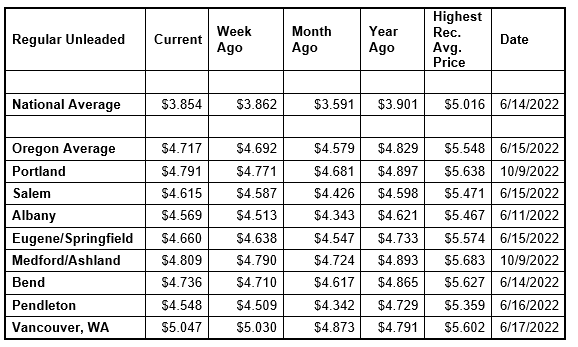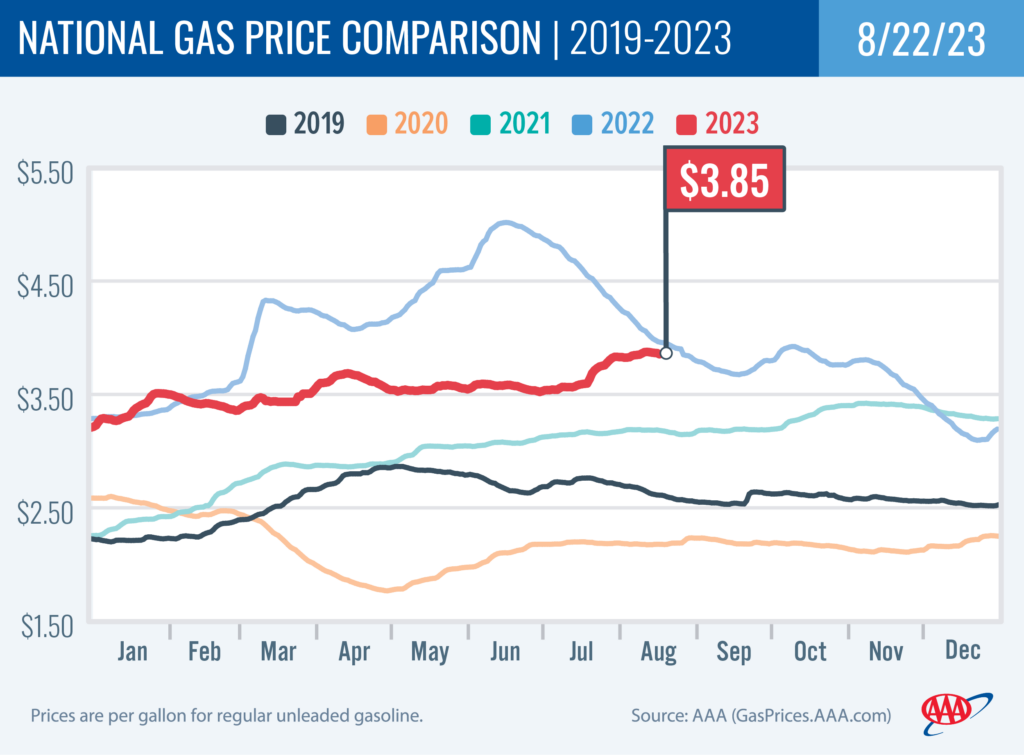PORTLAND, Ore., – The storm Hilary which battered California and sweltering temperatures across much of the U.S. from Texas to the Great Lakes may impact refinery production. Crude oil prices have moved a little lower and demand for gas in the U.S. has declined in the last week. But we may see reduced output from refineries which would put upward pressure on pump prices. For the week, the national average slips a penny to $3.85. The Oregon average adds three cents to $4.72.

Demand for gas is likely to increase leading up to Labor Day. AAA booking data for flights, hotels, rental cars and cruises shows Labor Day travel is up compared to last year. Domestic bookings are up 4% and international bookings are up 44%. Find all the details in the AAA Labor Day travel news release.
“Texas, Louisiana, Arkansas, Oklahoma and Kansas are some of the states that have been sweltering in triple-digit heat that is at or near records. All of these states have refineries that may have to again curb production because of the sizzling temperatures,” says Marie Dodds, public affairs director for AAA Oregon/Idaho. “In California and the southwest, the storm Hilary and its heavy rains and flooding sent wholesale prices for gas and diesel higher. Today it appears that the five refineries in the Los Angeles area came through the storm without major issues.”
Earlier this summer, extreme heat across much of the U.S. led to refinery outages. When temperatures soar above 100 degrees, refineries can’t operate at peak levels. All refineries in the U.S. are at least 50 years old and many are more than 100 years old. They were not designed to operate in extreme heat. Plus, they’re processing an extremely flammable product.
Higher crude oil prices have also put upward pressure on pump prices. Crude oil prices are up about 6% in the last month. Although prices have dipped a little since rising to $84 a barrel this month, they are still higher than they were for much of the year. The higher crude prices are driven in part by Saudi Arabia’s extension of its production cuts of one million barrels a day through September.
Crude oil is trading around $80 today compared to $81 a week ago and $90 a year ago. In July, West Texas Intermediate ranged between about $69 and $82 per barrel. In June, WTI ranged between about $67 and $73 per barrel. In May, WTI ranged between about $63 and $77 per barrel. In April, WTI ranged between about $73 and $83. In March, WTI ranged between about $64 and $81 per barrel. In February, WTI ranged between about $73 and $80 per barrel. In January, WTI ranged between about $73 and $82 bbl. Crude reached recent highs of $123.70 on March 8, 2022, shortly after the Russian invasion of Ukraine, and $122.11 per barrel on June 8, 2022. The all-time high for WTI crude oil is $147.27 in July 2008.
Crude oil is the main ingredient in gasoline and diesel, so pump prices are impacted by crude prices on the global markets. On average, about 47% of what we pay for in a gallon of gasoline is for the price of crude oil, 24% is refining, 14% distribution and marketing, and 14% are taxes, according to the U.S. Energy Information Administration.
Demand for gasoline slid from 9.30 million b/d to 8.85 million b/d for the week ending August 11, according to the U.S. Energy Information Administration (EIA). This compares to 9.35 million b/d a year ago. Meanwhile, total domestic gasoline stocks decreased slightly from 216.4 million bbl to 216.2 million bbl. Although demand has fallen, fluctuating oil prices have kept pump prices elevated.
Quick stats
Oregon is one of 19 states and the District of Columbia with higher prices now than a week ago. Arizona (+16 cents) has the largest weekly jump. Iowa (-12 cents) has the biggest weekly decrease.
California ($5.26) has the most expensive gas in the nation for the fourth week in a row. Washington ($5.05) is second. These are the only two states with averages at or above $5 a gallon. Hawaii ($4.79) is third, Oregon ($4.72) is fourth, Alaska ($4.53) is fifth, Nevada ($4.47) is sixth, Arizona ($4.24) is seventh, Utah ($4.23) is eighth, Illinois ($4.13) is ninth, Idaho ($4.12) is 10th, the District of Columbia ($4.04) is 11th, and Colorado ($4.02) is 12th. These are the 11 states and D.C. with averages at or above $4 a gallon, down from 12 states and D.C. a week ago. This week 39 states have averages in the $3-range. No state has an average in the $2 range this week.
The cheapest gas in the nation is in Mississippi ($3.31) and Louisiana ($3.41). For the 136th week in a row, no state has an average below $2 a gallon.
The difference between the most expensive and least expensive states is $1.95 this week, compared to $1.85 a week ago.
All 50 states and the District of Columbia have higher prices now than a month ago. The national average is 26 cents more and the Oregon average is 14 cents more than a month ago. This is the fourth-smallest monthly increase in the nation. Arizona (+47 cents) has the largest monthly jump. Hawaii (+10 cents) has the smallest.
Oregon is one of 36 states and the District of Columbia with lower prices now than a year ago. The national average is five cents less and the Oregon average is 11 cents less than a year ago. Hawaii (-53 cents) has the largest yearly drop. Washington (+28 cents) has the largest year-over-year increases.
West Coast
The West Coast region continues to have the most expensive pump prices in the nation with all seven states in the top 10. It’s typical for the West Coast to have six or seven states in the top 10 as this region tends to consistently have fairly tight supplies, consuming about as much gasoline as is produced. In addition, this region is located relatively far from parts of the country where oil drilling, production and refining occurs, so transportation costs are higher. And environmental programs in this region add to the cost of production, storage and distribution.
| Rank | Region | Price on 8/22/23 |
| 1 | California | $5.26 |
| 2 | Washington | $5.05 |
| 3 | Hawaii | $4.79 |
| 4 | Oregon | $4.72 |
| 5 | Alaska | $4.53 |
| 6 | Nevada | $4.47 |
| 7 | Arizona | $4.24 |
| 8 | Utah | $4.23 |
| 9 | Illinois | $4.13 |
| 10 | Idaho | $4.12 |
As mentioned above, California has the most expensive gas in the country. Washington, Hawaii, Oregon, Alaska, Nevada, and Arizona round out the top seven. Oregon is fourth for the 11th week in a row.
All states in the West Coast region are seeing week-over-week increases. Arizona (+16 cents) has the largest jump in the region and the nation. Hawaii (+2/10ths of a cent) has the smallest.
The refinery utilization rate on the West Coast increased from 90.5% to 91.6% for the week ending August 11. This rate has ranged between about 73% to 96% in the last year. The latest national refinery utilization rate rose from 93.8% to 94.7%.
According to EIA’s latest weekly report, total gas stocks in the region decreased slightly from 28.78 million bbl. to 28.18 million bbl.
A higher refinery utilization rate can put downward pressure on pump prices, while a decrease in gasoline stocks can put upward pressure on pump prices.
Oil market dynamics
Crude oil prices have backed away from $84 per barrel, the highest price since mid-April 2023, Markets are concerned that if interest rates continue to increase, the economy could tip into a recession. If it does, oil demand and prices would likely decline. Additionally, the EIA reported that total domestic commercial crude inventories decreased from 445.6 to 439.7 million bbl.
At the close of Friday’s formal trading session, WTI added $1.21 to settle at $81.25. At the close of Monday’s formal trading session, WTI lost 53 cents to settle at $80.72. Today crude is trading around $80 compared to $81 a week ago. Crude prices are about $10 less than a year ago.
Drivers can find current gas prices along their route with the free AAA Mobile app for iPhone, iPad and Android. The app can also be used to map a route, find discounts, book a hotel and access AAA roadside assistance. Learn more at AAA.com/mobile.

Diesel
For the week, the national average ticks up two cents to $4.35 a gallon. The record high is $5.816 set on June 19, 2022. The Oregon average jumps 10 cents to $4.86. The record high is $6.47 set on July 3, 2022. A year ago the national average for diesel was $4.98 and the Oregon average was $5.66.
Find current fuel prices at GasPrices.AAA.com.
AAA news releases, high resolution images, broadcast-quality video, fact sheets and podcasts are available on the AAA NewsRoom at NewsRoom.AAA.com.
Find local news releases at https://oregon.aaa.com/community/media/media-contacts.html
Fuel prices are updated daily at AAA’s Daily Fuel Gauge at AAA Gas Prices. For more info go www.AAA.com. AAA Oregon/Idaho provides more than 880,000 members with travel, insurance, financial and automotive-related services, and is an affiliate of AAA National, serving more than 63 million motorists in North America.

